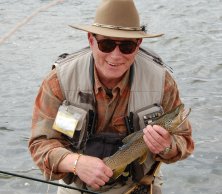As a fly fisherman , I 'm always in search for that notable fly.
The Baetis Imitation Tried and True
As a fly fisherman , I 'm always in search for that notable fly. The aquatic insect that will entice trout to feed through all seasons, even July and August, when the water is depressed and crystalline. From my own forging, I found that the Baetis has no limitations. Any trout stream in the east, that is uncontaminated and inclement you'll find Baetis Mayflies. Baetis nymphs are active through the entire year with consistent diel drift ( a regular movement in every 24 hr. period ). These diminutive mayflies are swimmers, but they will also dead drift with the current. This natural activity of drift usually transpires early morning or late evening. Trout will take these nymphs with very subdued movement. I only use two stages of the Baetis Mayflies through the dog days of summer, the nymph and the emerger. The patterns I use will deceive selective feeding trout during these hot and humid days. When I see trout feeding, below the meniscus to the bottom of the stream that is a good sign of natural drift. With this type of feeding, I will use a tandem rig of two nymphs with brown wing cases. I will start with the nymphs 12 to 14 inches apart. Keeping the end nymph bouncing off the stream bed and the second nymph higher in the water column. This method has given me excellent results. Remember fly fishing for trout is about adjustments. When observing the water and seeing ripples here and there, a dorsal fin and tail, maybe noses penetrating the meniscus, to me this means the beginning of a hatch. At this time I will still fish a tandem rig but making adjustments. These two flies will be fished 10 to 12 inches apart. The top fly will be a Baetis emerger presented half in the meniscus and half on top of the meniscus. The trailing fly will be a Baetis nymph with a black split wing case. This nymph will be fished in the meniscus or a inch or two below the meniscus. When the Baetis nymphs are close to hatching the body darkens with the wing pads turning black and the wing case splitting. The one nymph I tie will imitate this stage, remember selectivity. The Baetis nymphs reaching this stage will soon penetrate the meniscus to extract the exoskeleton and move on to adulthood. A larger selective trout will take an emerger with the trailing chuck still hanging from the abdomen or a nymph with the splitting exoskeleton before a high riding dry adult.
I was watching the weather one July evening and they were calling for the norm, hot and humid. I have not been fishing for a couple of days, so I decided to go the following day, at daybreak. Arriving at the parking lot, I changed into my waders, put my rod together, finished my coffee and already the sweat was running into my eyes. I walked down the narrow path to the stream and then to the beat I wanted to fish. My cloths and body were saturated by the time I arrived. It was beginning to break daylight and my eyes were glued to the water. There was not any trout activity that I could notice. So I decided to take a water temperature and do some seining to see what aquatic insects were available to the trout. I found many Baetis nymphs, with some of them being quite darker then others. Deciding to use the tandem rig with the emerger and the darker nymph with the black split wing case. On the first five casts I outwitted these two fine brown trout with the darker nymph,black split wing case. Baetis imitations are tried and true.
Patterns for the three Baetis used
Mike's Olive Baetis Nymph
Hook - Mustad 3906 B 16 - 22
Thread - UNI - 8/o Olive Dun
Tail - Pheasant Barbules
Rib - Vinyl Rib Green 16 - 20
Abdomen - Sheep Fleece - Olive
Wing Case - Thin Skin - Brown
Thorax - Brown Antron Hare's Ear
Mike's Baetis Split Wing Case
Hook - Mustad 3906 B 16 - 22
Thread - UNI 8/0 Camel
Tail - Pheasant Tail Barbules
Rib - Vinyl Rib Brown 16 - 20
Abdomen - Sheep Fleece Brown
Wing Case - Thin Skin Black
Thorax _ Brown Antron Hare's Ear
On Mike's Baetis Split Wing Case after whip finishing take a razor blade and make a slit in the center of the wing case going with the shank of the hook and without cutting the thread. Then take your bodkin and separate the slit just a little.
Baetis Emerger
Hook - TMC 2487 16 - 22
Thread - UNI - 8/o Camel
Trailing Shuck - Wapsi - Sparkle Yarn Brown
Rib - Ultra Wire Copper Sm
Abdomen - Pheasant Barbules
Thorax - Yellow Antron Dubbing
Wing - Gray Deer Hare

















